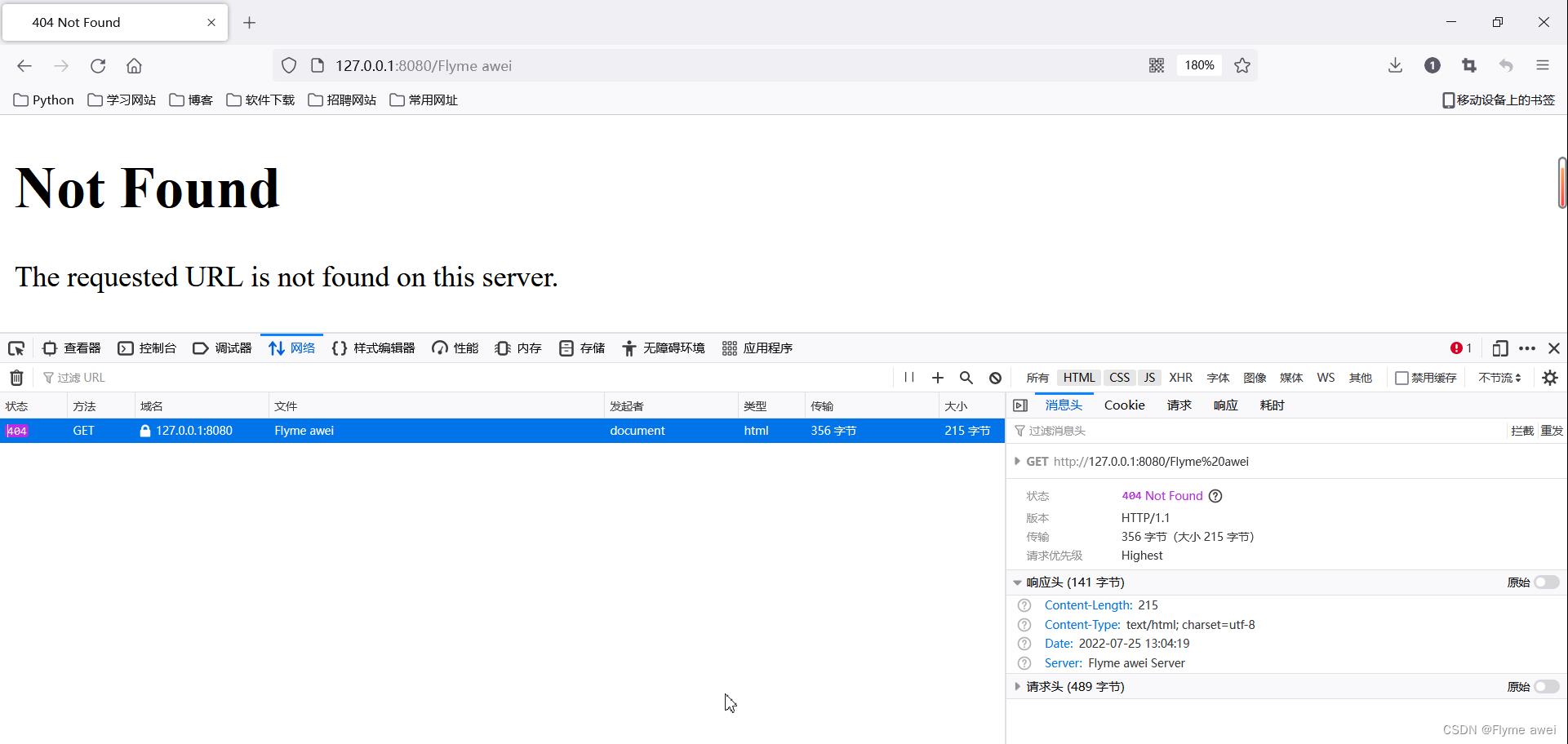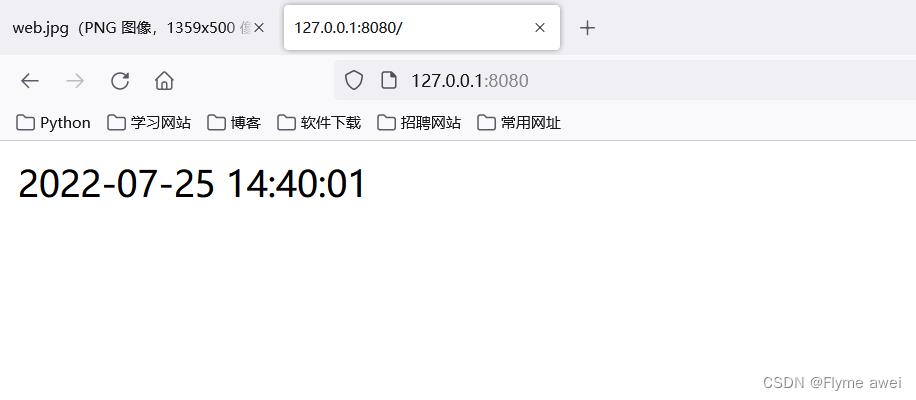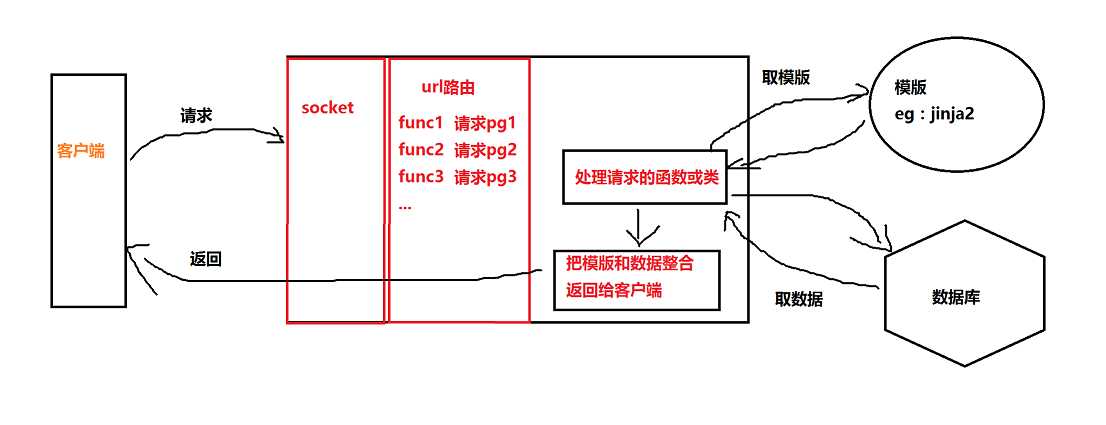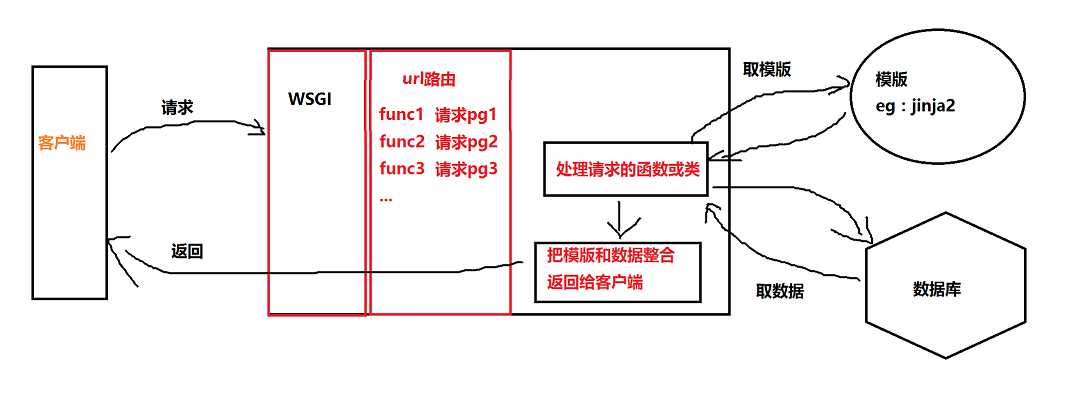Python开发自定义Web框架
Posted 北极的三哈
tags:
篇首语:本文由小常识网(cha138.com)小编为大家整理,主要介绍了Python开发自定义Web框架相关的知识,希望对你有一定的参考价值。

文章目录
开发自定义Web框架
接收web服务器的动态资源请求,给web服务器提供处理动态资源请求的服务。根据请求资源路径的后缀名进行判断:
如果请求资源路径的后缀名是
.html则是动态资源请求, 让web框架程序进行处理。
否则是静态资源请求,让web服务器程序进行处理。
1.开发Web服务器主体程序
1、接受客户端HTTP请求(底层是TCP)
# -*- coding: utf-8 -*-
# @File : My_Web_Server.py
# @author: Flyme awei
# @email : 1071505897@qq.com
# @Time : 2022/7/24 21:28
from socket import *
import threading
# 开发自己的Web服务器主类
class MyHttpWebServer(object):
def __init__(self, port):
# 创建 HTTP服务的 TCP套接字
server_socket = socket(AF_INET, SOCK_STREAM)
# 设置端口号互用,程序退出之后不需要等待,直接释放端口
server_socket.setsockopt(SOL_SOCKET, SO_REUSEADDR, True)
# 绑定 ip和 port
server_socket.bind(('', port))
# listen使套接字变为了被动连接
server_socket.listen(128)
self.server_socket = server_socket
# 处理请求函数
@staticmethod # 静态方法
def handle_browser_request(new_socket):
# 接受客户端发来的数据
recv_data = new_socket.recv(4096)
# 如果没有数据,那么请求无效,关闭套接字,直接退出
if len(recv_data) == 0:
new_socket.close()
return
# 启动服务器,并接受客户端请求
def start(self):
# 循环并多线程来接收客户端请求
while True:
# accept等待客户端连接
new_socket, ip_port = self.server_socket.accept()
print("客户端ip和端口", ip_port)
# 一个客户端的请求交给一个线程来处理
sub_thread = threading.Thread(target=MyHttpWebServer.handle_browser_request, args=(new_socket, ))
# 设置当前线程为守护线程
sub_thread.setDaemon(True)
sub_thread.start() # 启动子线程
# Web 服务器程序的入口
def main():
web_server = MyHttpWebServer(8080)
web_server.start()
if __name__ == '__main__':
main()
2、判断请求是否是静态资源还是动态资源
# 对接收的字节数据进行转换为字符数据
request_data = recv_data.decode('utf-8')
print("浏览器请求的数据:", request_data)
request_array = request_data.split(' ', maxsplit=2)
# 得到请求路径
request_path = request_array[1]
print("请求的路径是:", request_path)
if request_path == "/":
# 如果请求路径为根目录,自动设置为:/index.html
request_path = "/index.html"
# 判断是否为:.html 结尾
if request_path.endswith(".html"):
"动态资源请求"
pass
else:
"静态资源请求"
pass
3、如果静态资源怎么处理?

"静态资源请求"
# 根据请求路径读取/static 目录中的文件数据,相应给客户端
response_body = None # 响应主体
response_header = None # 响应头的第一行
response_first_line = None # 响应头内容
response_type = 'test/html' # 默认响应类型
try:
# 读取 static目录中相对应的文件数据,rb模式是一种兼容模式,可以打开图片,也可以打开js
with open('static'+request_path, 'rb') as f:
response_body = f.read()
if request_path.endswith('.jpg'):
response_type = 'image/webp'
response_first_line = 'HTTP/1.1 200 OK'
response_header = 'Content-Length:' + str(len(response_body)) + '\\r\\n' + \\
'Content-Type: ' + response_type + '; charset=utf-8\\r\\n' + \\
'Date:' + time.strftime('%Y-%m-%d %H:%M:%S', time.localtime()) + '\\r\\n' + \\
'Server: Flyme awei Server\\r\\n'
# 浏览器读取的文件可能不存在
except Exception as e:
with open('static/404.html', 'rb') as f:
response_body = f.read() # 响应的主体页面内容
# 响应头
response_first_line = 'HTTP/1.1 404 Not Found\\r\\n'
response_header = 'Content-Length:'+str(len(response_body))+'\\r\\n' + \\
'Content-Type: text/html; charset=utf-8\\r\\n' + \\
'Date:' + time.strftime('%Y-%m-%d %H:%M:%S', time.localtime()) + '\\r\\n' + \\
'Server: Flyme awei Server\\r\\n'
# 最后都会执行的代码
finally:
# 组成响应数据发送给(客户端)浏览器
response = (response_first_line + response_header + '\\r\\n').encode('utf-8') + response_body
new_socket.send(response)
# 关闭套接字
new_socket.close()

静态资源请求验证:

4、如果动态资源又怎么处理
if request_path.endswith(".html"):
"动态资源请求"
# 动态资源的处理交给Web框架来处理,需要把请求参数交给Web框架,可能会有多个参数,采用字典结构
params =
'request_path': request_path
# Web框架处理动态资源请求后,返回一个响应
response = MyFramework.handle_request(params)
new_socket.send(response)
new_socket.close()
5、关闭Web服务器
new_socket.close()
Web服务器主体框架总代码展示:
# -*- coding: utf-8 -*-
# @File : My_Web_Server.py
# @author: Flyme awei
# @email : 1071505897@qq.com
# @Time : 2022/7/24 21:28
import sys
import time
from socket import *
import threading
import MyFramework
# 开发自己的Web服务器主类
class MyHttpWebServer(object):
def __init__(self, port):
# 创建 HTTP服务的 TCP套接字
server_socket = socket(AF_INET, SOCK_STREAM)
# 设置端口号互用,程序退出之后不需要等待,直接释放端口
server_socket.setsockopt(SOL_SOCKET, SO_REUSEADDR, True)
# 绑定 ip和 port
server_socket.bind(('', port))
# listen使套接字变为了被动连接
server_socket.listen(128)
self.server_socket = server_socket
# 处理请求函数
@staticmethod # 静态方法
def handle_browser_request(new_socket):
# 接受客户端发来的数据
recv_data = new_socket.recv(4096)
# 如果没有数据,那么请求无效,关闭套接字,直接退出
if len(recv_data) == 0:
new_socket.close()
return
# 对接收的字节数据进行转换为字符数据
request_data = recv_data.decode('utf-8')
print("浏览器请求的数据:", request_data)
request_array = request_data.split(' ', maxsplit=2)
# 得到请求路径
request_path = request_array[1]
print("请求的路径是:", request_path)
if request_path == "/":
# 如果请求路径为根目录,自动设置为:/index.html
request_path = "/index.html"
# 判断是否为:.html 结尾
if request_path.endswith(".html"):
"动态资源请求"
# 动态资源的处理交给Web框架来处理,需要把请求参数交给Web框架,可能会有多个参数,采用字典结构
params =
'request_path': request_path
# Web框架处理动态资源请求后,返回一个响应
response = MyFramework.handle_request(params)
new_socket.send(response)
new_socket.close()
else:
"静态资源请求"
# 根据请求路径读取/static 目录中的文件数据,相应给客户端
response_body = None # 响应主体
response_header = None # 响应头的第一行
response_first_line = None # 响应头内容
response_type = 'test/html' # 默认响应类型
try:
# 读取 static目录中相对应的文件数据,rb模式是一种兼容模式,可以打开图片,也可以打开js
with open('static'+request_path, 'rb') as f:
response_body = f.read()
if request_path.endswith('.jpg'):
response_type = 'image/webp'
response_first_line = 'HTTP/1.1 200 OK'
response_header = 'Content-Length:' + str(len(response_body)) + '\\r\\n' + \\
'Content-Type: ' + response_type + '; charset=utf-8\\r\\n' + \\
'Date:' + time.strftime('%Y-%m-%d %H:%M:%S', time.localtime()) + '\\r\\n' + \\
'Server: Flyme awei Server\\r\\n'
# 浏览器读取的文件可能不存在
except Exception as e:
with open('static/404.html', 'rb') as f:
response_body = f.read() # 响应的主体页面内容
# 响应头
response_first_line = 'HTTP/1.1 404 Not Found\\r\\n'
response_header = 'Content-Length:'+str(len(response_body))+'\\r\\n' + \\
'Content-Type: text/html; charset=utf-8\\r\\n' + \\
'Date:' + time.strftime('%Y-%m-%d %H:%M:%S', time.localtime()) + '\\r\\n' + \\
'Server: Flyme awei Server\\r\\n'
# 最后都会执行的代码
finally:
# 组成响应数据发送给(客户端)浏览器
response = (response_first_line + response_header + '\\r\\n').encode('utf-8') + response_body
new_socket.send(response)
# 关闭套接字
new_socket.close()
# 启动服务器,并接受客户端请求
def start(self):
# 循环并多线程来接收客户端请求
while True:
# accept等待客户端连接
new_socket, ip_port = self.server_socket.accept()
print("客户端ip和端口", ip_port)
# 一个客户端的请求交给一个线程来处理
sub_thread = threading.Thread(target=MyHttpWebServer.handle_browser_request, args=(new_socket, ))
# 设置当前线程为守护线程
sub_thread.setDaemon(True)
sub_thread.start() # 启动子线程
# Web 服务器程序的入口
def main():
web_server = MyHttpWebServer(8080)
web_server.start()
if __name__ == '__main__':
main()
2.开发Web框架主体程序
1、根据请求路径,动态的响应对应的数据
# -*- coding: utf-8 -*-
# @File : MyFramework.py
# @author: Flyme awei
# @email : 1071505897@qq.com
# @Time : 2022/7/25 14:05
import time
# 自定义Web框架
# 处理动态资源请求的函数
def handle_request(parm):
request_path = parm['request_path']
if request_path == '/index.html': # 当前请求路径有与之对应的动态响应,当前框架只开发了 index.html的功能
response = index()
return response
else:
# 没有动态资源的数据,返回404页面
return page_not_found()
# 当前 index函数,专门处理index.html的请求
def index():
# 需求,在页面中动态显示当前系统时间
data = time.strftime('%Y-%m-%d %H:%M:%S', time.localtime())
response_body = data
response_first_line = 'HTTP/1.1 200 OK\\r\\n'
response_header = 'Content-Length:' + str(len(response_body)) + '\\r\\n' + \\
'Content-Type: text/html; charset=utf-8\\r\\n' + \\
'Date:' + time.strftime('%Y-%m-%d %H:%M:%S', time.localtime()) + '\\r\\n' + \\
'Server: Flyme awei Server\\r\\n'
response = (response_first_line + response_header + '\\r\\n' + response_body).encode('utf-8')
return response
def page_not_found():
with open('static/404.html', 'rb') as f:
response_body = f.read() # 响应的主体页面内容
# 响应头
response_first_line = 'HTTP/1.1 404 Not Found\\r\\n'
response_header = 'Content-Length:' + str(len(response_body)) + '\\r\\n' + \\
'Content-Type: text/html; charset=utf-8\\r\\n' + \\
'Date:' + time.strftime('%Y-%m-%d %H:%M:%S', time.localtime()) + '\\r\\n' + \\
'Server: Flyme awei Server\\r\\n'
response = (response_first_line + response_header + '\\r\\n').encode('utf-8') + response_body
return response
2、如果请求路径,没有对应的响应数据也需要返回404页面

3.使用模板来展示响应内容
1、自己设计一个模板 index.html ,中有一些地方采用动态的数据来替代
<!DOCTYPE html>
<html lang="zh-CN">
<head>
<meta charset="utf-8">
<meta http-equiv="X-UA-Compatible" content="IE=edge">
<meta name="viewport" content="width=device-width, initial-scale=1">
<title>首页 - 电影列表</title>
<link href="/css/bootstrap.min.css" rel="stylesheet">
<script src="/js/jquery-1.12.4.min.js"></script>
<script src="/js/bootstrap.min.js"></script>
</head>
<body>
<div class="navbar navbar-inverse navbar-static-top ">
<div class="container">
<div class="navbar-header">
<button class="navbar-toggle" data-toggle="collapse" data-target="#mymenu">
<span class="icon-bar"></span>
<span class="icon-bar"></span>
<span class="icon-bar"></span>
</button>
<a href="#" class="navbar-brand">电影列表</a>
</div>
<div class="collapse navbar-collapse" id="mymenu">
<ul class="nav navbar-nav">
<li class="active"><a href="">电影信息</a></li>
<li><a href="">个人中心</a></li>
</ul>
</div>
</div>
</div>
<div class="container">
<div class="container-fluid">
<table class="table table-hover">
<tr>
<th>序号</th>
<th>名称</th>
<th>导演</th>
<th>上映时间</th>
<th>票房</th>
<th>电影时长</th>
<th>类型</th>
<th>备注</th>
<th>删除电影</th>
1 #!/usr/bin/env python
2 # -*- coding:utf8 -*-
3
4 import socket
5
6
7 def handle_request(client):
8 buf = client.recv(1024)
9 client.send(b"HTTP/1.1 200 OK \\r\\n\\r\\n")
10 # with open(‘./html/index.html‘,‘r‘) as f: #执行时这里报错 错误详情下文有说明
11 with open(‘./html/index.html‘, ‘rb‘) as f:
12 client.send(f.read())
13
14
15 def main():
16 ip_port = (‘127.0.0.1‘,9999)
17 sock = socket.socket(socket.AF_INET,socket.SOCK_STREAM)
18 sock.bind(ip_port)
19 sock.listen()
20
21 while True:
22 conn, addr = sock.accept()
23 handle_request(conn)
24 conn.close()
25
26
27 if __name__ == ‘__main__‘:
28 print("\\033[31;1m Server is running... \\033[0m")
29 main()
在这里遇到一个小问题,pycharm执行报错:
UnicodeDecodeError: ‘gbk‘ codec can‘t decode byte 0x80 in position 84: illegal multibyte sequence
解决办法:
(1)修改打开文件方式为 ‘rb‘
with open(‘./html/index.html‘, ‘rb‘) as f:
client.send(f.read())
(2)在打开时设置编码
with open(‘./html/index.html‘, ‘r‘,encoding=‘utf-8‘) as f:
client.send(f.read())
2基于socket的web框架
这种实现方式的web框架主要有Tornado

3、基于WSGI的web框架
目前主流的部分web框架,如Django、Flask...都是采用这样的方式

以上是关于Python开发自定义Web框架的主要内容,如果未能解决你的问题,请参考以下文章